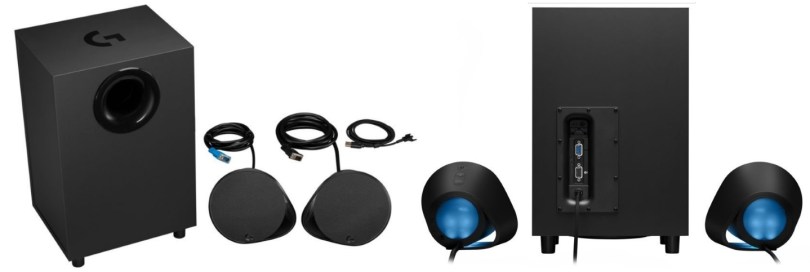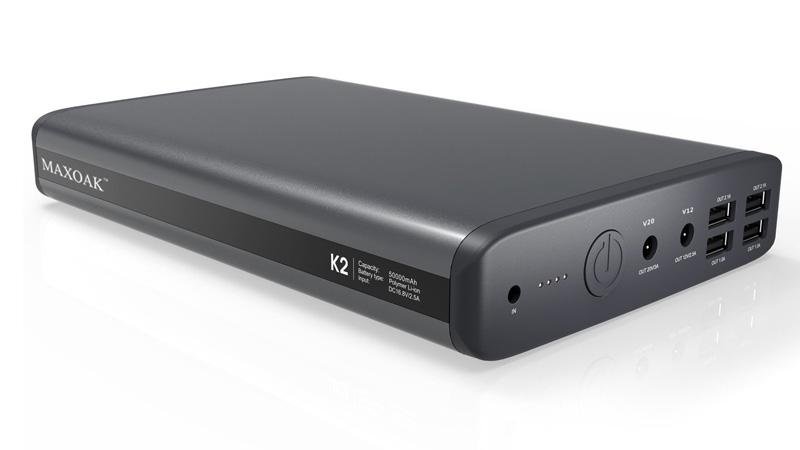Last Updated on May 1, 2024 by Daniel Osakwe
Gaming headsets do have their place, especially for those who are competitive and require a mic nearby. Otherwise, a good set of speakers is often the best choice. This allows you to hear deep, rich sounds without the need for restrictive headgear – and you will be able to share your gaming experiences with friends and loved ones. Introducing the Logitech G560 Gaming Speaker: a full-featured, three-part peripheral that also features a very impressive light show.
Essentially, the G560 is a speaker that can play music and games at the same time. Anyone familiar with existing Logitech speakers will not be surprised by its success here.
Additionally, Logitech has integrated a sophisticated lighting system with four distinct zones that display colorful LEDs. It is a pretty light show, but some issues with the software will cause it to be distracting, and the default lighting can be too harsh.
Nevertheless, if you want some of the best computer speakers that put PC gaming in the spotlight, this Logitech G560 review shows why it’s a worthwhile purchase for a reasonable price.
Table of Contents
Logitech G560 Gaming Speaker: Design
It looks complicated but isn’t as complicated as it appears. (The set-up instructions can be found right on the box without any text, which is reassuring.) A rectangular subwoofer, which will probably live on your floor, acts as the focal point of the setup. Afterward, you connect two circular speakers to your desk (with monitor cables, so that the lights can be incorporated). The subwoofer also comes with a USB and power cable that connect directly to the computer.
Once the speakers are connected, you need to deal with a few cables, but that’s about it. The left speaker is just a speaker; the right speaker has a volume control on top, as well as a button that controls the RGB lighting intensity. You can turn off the speakers and pair a Bluetooth device by using the buttons around the back.
A lot of people will be drawn to the G560 if they care about the appearance of their game center. Subwoofers are plain and black to blend with any setting.
It has a distinctive shape that does not detract attention from the surrounding environment while remaining streamlined and attractive. It’s important to set the lighting up correctly. (The intensity of the lighting can be controlled.)
In the widest point they are 7.5 x 6.0 inches in size (compare this to the Razer Nommo speakers, which are about a foot tall and 8 inches across). For desks with limited space, you may want to consider vertically inclined speakers.
Despite its physical design, the G560 has one big flaw: The speakers route directly through the subwoofer, so it is not possible to turn it completely off. Subwoofer owners will know that bass vibrations often distract more than even moderately loud music, especially late at night.
Even operating your speakers early in the morning or late at night can become problematic if you share a wall with your parents or children. Logitech Gaming Software allows you to turn down the bass volume, and the right speaker also has a headphone jack. Neither of these solutions, however, are perfect.
In addition to its treble-forward sound, the headphone jack is well hidden and can be hazardous for short cables. By reducing the bass, you will silence the woofer, but you will also stop hearing bass through the regular speakers. You may find the G560 a tough sell if late-night gaming is your thing but you need quiet performance.
Logitech G560 Gaming Speaker: Gaming performance
Despite its ability to handle any sound source, the G560 is primarily designed as a PC gaming peripheral. As such, I rigorously tested it with games ranging from competitive first-person shooters to story-driven single-player RPGs (you can get similar non-gaming setups from Logitech for about $100).
Regardless of the genre, the G560 provided a rich, immersive sound. The audio played smoothly regardless of the surround format I used (with a preset gaming EQ profile) or the standard stereo. I could hear all the voice work, sound effects, and music I needed. The roar of gunfire was at the center of Overwatch, while Pillars of Eternity was filled with orchestral music. With the G560’s surround sound support, you can even place your speakers creatively and feel like a whole game is taking place right in front of you.
It’s comparable to what you hear from high-end headsets due to the two circular speakers. It may be difficult, however, to explain the impact of a subwoofer if you’ve never played with one. If you have a woofer placed in your feet or legs, you might even feel the bass music and explosions in your gut and in your thighs and feet. The woofer is very noticeable even at low volumes. It will certainly make your gameplay feel more immediate and realistic, but I can’t say it’ll give you an edge in competition.
The G560 is a powerful speaker, so punk rockers in the crowd need not worry. For fear of blowing out some actual, physical windows, I’ve been hesitant to crank the volume past about 20 on Windows 10. With the G560, you could get the party started at a house party or maybe even in a small bar. However, even if it handles the top part of the spectrum well, you can’t actually make it that quiet on a PC.
Even with the volume turned down to its lowest setting, the G560 easily filled the private office where I set it up. After raising the volume, I could clearly hear it through the glass door. At work or when playing games, this wasn’t a problem during the day; however, when playing music late at night with no background noise at home, I may need even quieter speakers.
Although individual games and apps let you adjust the volume, it’s no longer as simple as just hitting the volume button. A simple pressing of the button can cause problems. The volume-up button is adjacent to the brightness button, so you can imagine how often I have mixed those up.
Logitech G560 Gaming Speaker review: Software and RGB lighting
While the software is often an added bonus with Logitech’s mice and keyboards, this speaker’s software functions very integrally. With the Logitech Gaming Software, you can not only configure lighting options but also activate surround sound, change equalization settings, and set up profiles based on individual games.
For the most part, the G560’s integrated lighting sets it apart from the competition. There are a lot of cool things you can accomplish with the G560 thanks to the four distinct zones of lighting, including attractive color cycling and pre-programmed patterns in games such as Fortnite and Final Fantasy XIV. (Alternatively, you can turn the lights completely off if you like eating plain Cheerios and listening to Imagine Dragons.)
In addition, the coolest lighting option available tends to be the least consistent. With Logitech’s “screen sampler,” you can divide your desktop screen into four quadrants and take color samples from each. The four colors of the G560 will correspond to its four lighting zones. Let’s say you’re playing StarCraft while controlling the Terran base on the upper-left while waging war against the Zerg on the bottom-right. You’ll see calming grays and blues on one speaker; browns, purples, reds, and yellows will appear on another.
Occasionally, it does work like that. Most often, the screen sampler is very sensitive and will flash a wide range of colors, at various intensities, even faster than the default color cycle. I found it a bit dizzying to watch. As a result, I reduced the color sensitivity to a more manageable level, but this required a deeper dive into the sampling options. Furthermore, with only four quadrants on screen at a time, it can be difficult to set up the perfect distribution (or else rely on eidetic memory).
Similar to the Nommo Chroma speakers ($150), the Razer Nommo Chroma features colorful LED lighting that is synced with the other Razer products. However, there is no screen-sampling feature, and unless you program your own lighting patterns, there is no game-specific lighting.
We should also point out that you should disable the Nvidia GeForce Experience software if you have it installed, otherwise your games will not switch lighting or sound profiles automatically. Despite the fact that this isn’t a Logitech software bug, learning from my error could make your life easier.
It is also possible to switch the lighting options to the hardware with Logitech Gaming Software. This app allows you to have a fancy lighting show while connected via Bluetooth – an excellent party app. However, the USB cable is understandably better at delivering audio quality because it is easier and more convenient than Bluetooth.
Music performance
Those familiar with Logitech’s everyday speakers won’t be surprised to hear that the G560 is just as good at handling music and movies as it is at playing video games. Music and movies sound better when they’ve listened to in 7.1 surround sound; a stereo setting sounds just as robust and nuanced.
Using my playlist, I played the G560 with rock, bluegrass, punk, classical, and so on. I loved the balance between Old Crow Medicine Show’s twangy bass and Flogging Molly’s aggressive accordion. The Violin Concerto in E Major by Bach was especially enjoyable because I could clearly distinguish each part, including the prominent violin and almost inaudible harpsichord.
| Pros | Cons |
| Bluetooth connectivity | Screen sampling can be overly aggressive |
| Robust software | Disabling the subwoofer is not possible |
| Extensive lighting options |
Verdict
Lighting ambitions sometimes outpace performance on the Logitech G560. It would be nice if you had more control over the volume at low levels and could disable the subwoofer. Despite this, though, the G560 is a promising first attempt at a gaming speaker system. Perhaps this isn’t surprising given Logitech’s track record for both speakers and gaming peripherals, but it’s still good news.








